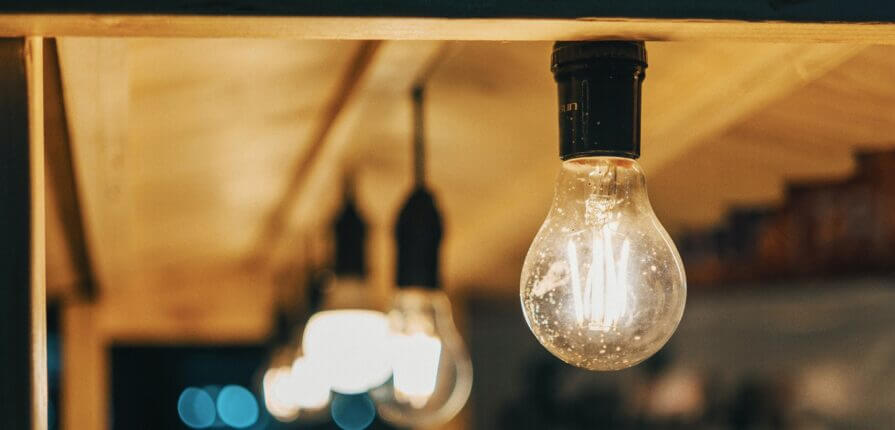A well-maintained home with beautiful landscaping deserves to be beautifully lighted. It’s easy to focus on choices like the fixtures, spacing, and overall design of the lighting system. It’s also important to consider the light itself: the intensity and “tone” of the light emitted by each bulb. Here’s what you need to know to choose the best outdoor lighting color temperature for your home.
What Is Outdoor Lighting Color Temperature?
The term color temperature is used for the tone, or appearance, of the light provided by a bulb. It is measured in degrees of Kelvin (K) and is on a scale from 1,000 to 10,000. A light bulb’s color temperature tells you what the look and feel of the produced light will be. The color temperature of a light bulb is assigned using the basis of correlated color temperature (CCT). An example of CCT is that if you heat a metal object, the object will appear to glow. Depending on what Kelvin temperature the metal object is being heated at, the glow will range from orange, yellow, or blue. The color temperature of light bulbs is intended to replicate the Kelvin temperature of the metal object.
Outdoor lighting color temperature is typically divided into three categories: warm white, warm natural white, and cool daylight white. Each one evokes a different ambiance. Warm white is intended to be cozy and inviting. Warm, natural white is meant to be welcoming and, well, natural. Cool, daylight white is intended to be crisp and refreshing.
Color Temperature Options for LED Outdoor Lighting
2700K Warm White
Outdoor lighting with the color temperature of warm white (2700K) is often seen in wall sconces. It’s a great choice for entry lighting, or downlighting along a pathway, or wash lighting. Warm white creates illumination that appears romantic, cozy, and welcoming. In outdoor wall-mounted fixtures, warm white can create a beautiful ambiance without too harsh of a light. Lighting at this color temperature allows for better safety and a gorgeous glow, with no harsh tones or shades. Look for this color when creating your outdoor bistro space.
3000K Natural White
Suppose you are looking to highlight and accentuate the vegetation in your landscaping. In that case, warm or natural light (3000K) may be just right. It is much cooler than warm white lighting. It is the lighting color temperature preferred by many professional landscape designers. The cooler tone accentuates greens and blues in vegetation. It can create a stunning look in the evening when used to highlight trees, ferns, and other large landscaping shrubs. It is also a perfect choice for lighting water features and fountains as it illuminates the natural color of the water without giving it an artificial appearance.
4000K Cool White
Lighting in the cool white (4000K) family is going to be, as it says in the name, the coolest of all the whites. It is the best choice for moonlighting (details below). Lights at 4000K are usually the lowest you will see in security floodlights. If you are interested in upgrading any of your security or motion sensor flood lights, this temperature can be a great option that provides peace of mind without being quite as bright as security lights used commercially. Your neighbors will probably thank you for that.
What Color Temperature Is Best for Home Uplighting?
Uplighting is used on a home’s exterior to create a polished, welcoming appearance. Uplighting accentuates the overall look of the home as well as architectural elements, such as windows, columns, or stunning exterior doors. When uplighting, warmer color temperatures between 2500-2700k tend to work best. This color temperature invites guests to enter your home and creates an expensive and classic look from the street. If you go too cool, you may risk your exterior looking too stark or industrial.
What Color Temperature is Best for Landscape Lighting?
Landscape lighting aims to highlight the vegetation in either your backyard or front landscaping. The best choice for this is a warm or natural white light in the 3000K range; as mentioned above, it’s often the preferred choice of landscape designers. The more natural hue showcases plants perfectly. It’s also a great tone for lighting water features. For great landscape lighting, use natural white light bulbs in outdoor spotlights that can be adjusted to capture landscaping at just the right angle.
What Is Moonlighting?
Moonlighting may be the perfect outdoor lighting concept if you have a landscape with mature trees. Moonlighting is done by placing a light high in a tree, pointed downward, giving the illusion that moonlight is filtering down through the leaves. To achieve moonlighting, 4000K lights are the best choice. The cool color temperature replicates natural moonlight well. Moonlighting can be used to beautifully light outdoor dining spaces and create gorgeous shadowing when used in combination with arbors and metalwork. When done correctly, the art of moonlighting can produce stunning effects.
If I Don’t Like the Color Temperature, Can I Change It?
The ability to change your exterior lights’ color temperature depends on the light fixture themselves. Outdoor sconces and wall lights can be switched as easily as changing a lightbulb. In contrast, some spotlights and underwater lights work with only one particular bulb and color temperature. If you think you may want to change the color temperature based on the seasons, decorations, or other factors,make sure to invest in outdoor lighting fixtures that work with bulbs of varying color temperatures.
Choosing the best outdoor lighting color temperature depends on what you are looking to illuminate and the aesthetic you are trying to achieve. We love helping our customers figure out what best suits their style, landscaping, overall goals, and budget. With the proper lighting, your home is bound to be the most appealing one on the street. Get in touch to schedule a free consultation!

